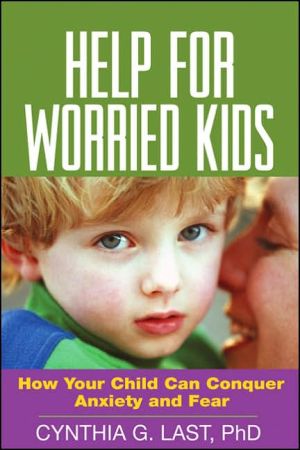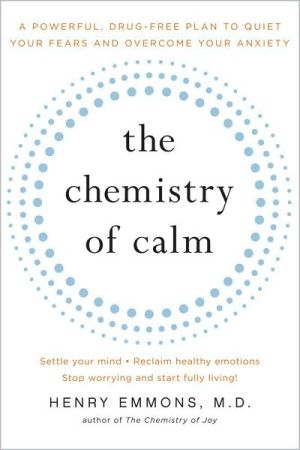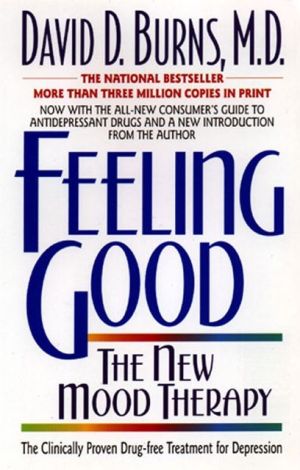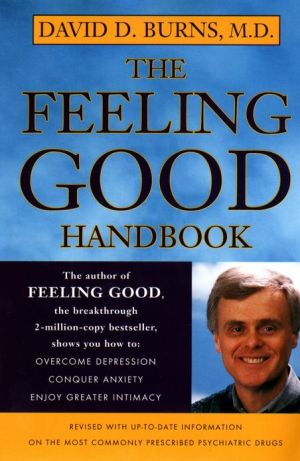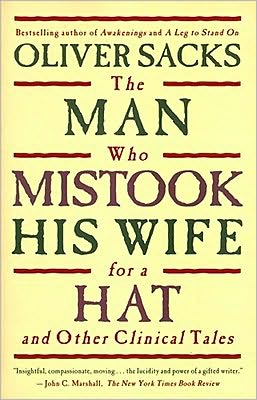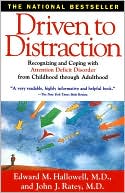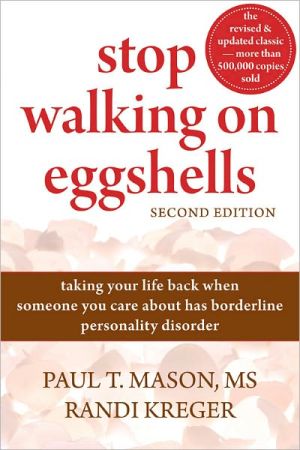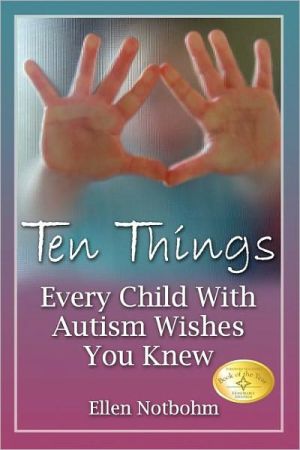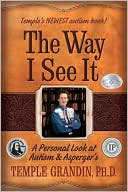Help for Worried Kids: How Your Child Can Conquer Anxiety and Fear
Most childhood fears are nothing to worry about. But panic attacks, phobias, and persistent anxiety can darken a child's horizons and lead to disrupted sleep, lower grades, and missed opportunities to make friends and explore the world. Dr. Cynthia G. Last helps parents determine when a child's apprehension is cause for concern. Drawing on 25 years of clinical practice and research, she vividly illustrates the different forms that childhood anxiety can take and offers practical solutions...
Search in google:
If your son begs to stay home from school to avoid speaking in front of the class, should you be worried? If your daughter insists on crossing the street whenever she sees a dog, what should you do? A simple evaluation devised by renowned psychologist Dr. Cynthia G. Last can help you determine if you have reason to be concerned. If so, you can use Dr. Last’s checklists and examples to figure out the type and severity of your child’s anxiety, identify contributing factors, and tackle the problem head on. Strategies tailored for different kinds of anxiety will guide you in preventing new episodes, calming your child when a problem arises, and keeping anxieties in check as your son or daughter matures. Dr. Last delivers powerful advice and insightful information gleaned from 25 years of experience working with worried kids and their families, including coping and relaxation skills your child can use to reduce stress and worry, and tips for encouraging kids to approach--not avoid--their fears. Whether your son or daughter can’t go on sleepovers, gets nervous around peers, or just plain worries about “everything,” this reassuring and compassionate book will teach you how to soothe your child’s immediate fears and instill lasting confidence. Publishers Weekly Mixing case histories with clinical research, Last shows parents how to tell the difference between common childhood fears (e.g., monsters under the bed) and more serious psychological problems (e.g., separation anxiety or obsessive compulsive disorder). The author, a clinical psychologist and expert on anxiety disorders, relies heavily on anecdotes from children suffering from anxiety disorders to illustrate the afflictions and how to handle them (in addition to the disorders mentioned earlier, Last also covers social anxiety disorder, generalized anxiety disorder and specific phobias). While the sketches are well drawn, they are somewhat repetitive. The book is at its best when it offers parents "hands-on" information, such as the chart outlining ages when common childhood fears begin and another on the differences between children with anxiety disorders and children with ADHD. There is also valuable material on the connection between anxiety and physical symptoms such as headaches and stomach problems; the effects caffeine, sugar and environmental toxins can have on children; and the roles medical problems like allergies, asthma, hypothyroidism and diabetes can play in causing anxiety or making it worse. Concerned parents will find plenty of useful advice here for quelling their children's fears. (Jan. 23) Copyright 2005 Reed Business Information.
I. Understanding Your Anxious Child1. Do You Have an Anxious Child?2. The Many Faces of Childhood Anxiety3. Nature or Nurture?: The Causes of Childhood Anxiety DisordersII. The Anxiety Disorders of Childhood4. "Will You Still Be There Tomorrow?": Separation Anxiety Disorder5. "But Mom, What If...?!": Generalized Anxiety Disorder6. Over and Over Again: Obsessive-Compulsive Disorder7. Self-Conscious to a Fault: Social Anxiety DisorderChapter 8. "Mommy, Daddy, I'm Afraid!": Specific PhobiasResources: If Your Child Needs Professional HelpSelected Scientific Articles by the Author
\ From the Publisher"If your child's worrying is interfering with his or her life, then you should read this book. It is an authoritative guide to current knowledge on childhood anxiety disorders, written in a clear, engaging style. To develop more courage, your child needs to learn how to cope with anxiety. This book shows what you can do to help."--Professor Alan Carr, PhD, Director of Clinical Psychology Training, University College Dublin, Ireland\ “Help for Worried Kids can help you determine if your child’s anxiety goes beyond the realm of 'normal,' and offers specific, clearly explained steps that you, as a parent, can take to help your child."--Elizabeth Skagen, parent of an 8-year-old with anxiety disorders\ "From a renowned, experienced clinical researcher and therapist, this extremely useful book will be helpful not only to parents of anxious kids, but also to teachers and health professionals. Dr. Last provides very detailed, carefully worked-out guidelines on how to understand and deal with different types of childhood anxiety problems. Filled with practical suggestions, this is an outstanding resource that is both informative and highly readable."--Paul M. G. Emmelkamp, PhD, Department of Psychology, University of Amsterdam, The Netherlands\ "Dr. Last has made a much-needed contribution to the growing field of childhood anxiety disorders. Based on her years of extensive research and clinical work, she shares her in-depth understanding of this population in an easy-to-read, conversational style. Dr. Last does an extraordinary job of illustrating the various presentations of anxiety in children, explaining the treatment process, and offering parenting advice specifically tailored for each anxiety disorder. This instructive book will be a valuable asset to parents, teachers, guidance counselors, and others who wish to gain a better understanding of anxiety in children."--Ana Kelton-Brand, PhD, private practice, Boca Raton, Florida\ "Is your child anxious? Is the problem severe enough to need treatment, or just a passing phase? Dr. Cynthia Last, a master child therapist and a leader in the diagnosis and treatment of childhood anxiety, helps you answer these questions in this valuable book. Dr. Last also provides state-of-the-art strategies for helping your child conquer his or her anxiety and fear before it takes a larger toll. Every parent will want to be aware of this information."--David H. Barlow, PhD, Center for Anxiety and Related Disorders and Department of Psychology, Boston University\ \ \ \ \ \ \ Child and Family Journal"This is a great resource book for parents, of this age group, and practitioners to use when working together. It is written in a friendly, clear, concise, factual manner. The checklists provide clearly categorized symptoms and strategies laid out in a way that promotes understanding and respect for the anxious child within the context of child development....I highly recommend this book as a gift for parents of an anxious child or as a working tool for educators, consultants, and mental health practitioners."--Child and Family Journal\ \ \ Publishers WeeklyMixing case histories with clinical research, Last shows parents how to tell the difference between common childhood fears (e.g., monsters under the bed) and more serious psychological problems (e.g., separation anxiety or obsessive compulsive disorder). The author, a clinical psychologist and expert on anxiety disorders, relies heavily on anecdotes from children suffering from anxiety disorders to illustrate the afflictions and how to handle them (in addition to the disorders mentioned earlier, Last also covers social anxiety disorder, generalized anxiety disorder and specific phobias). While the sketches are well drawn, they are somewhat repetitive. The book is at its best when it offers parents "hands-on" information, such as the chart outlining ages when common childhood fears begin and another on the differences between children with anxiety disorders and children with ADHD. There is also valuable material on the connection between anxiety and physical symptoms such as headaches and stomach problems; the effects caffeine, sugar and environmental toxins can have on children; and the roles medical problems like allergies, asthma, hypothyroidism and diabetes can play in causing anxiety or making it worse. Concerned parents will find plenty of useful advice here for quelling their children's fears. (Jan. 23) Copyright 2005 Reed Business Information.\ \ \ \ \ Library JournalThese two books build on each other. Written by a clinical psychologist specializing in cognitive-behavioral treatment for anxiety disorders, Help for Worried Kids introduces the topic of childhood anxiety disorders. The text opens with a discussion of the causes of childhood anxiety, its many "faces," and how to identify an anxious child. The second part is dedicated to the disorders themselves, with each chapter offering an in-depth examination that includes prevention, diagnosis, personal narratives, and advice on helping children gain control over fear and anxiety. A good selection of resources, check lists, and worksheets rounds out the text. This book is geared to concerned parents looking for help in determining whether their child's uneasiness is reason for concern. In contrast, Worried No More is geared not only to parents but also to school and healthcare professionals; it reads like a training guide for those with a daily need to understand and help children experiencing serious anxiety. Clinical child psychologist Wagner has a unique approach to making cognitive-behavioral therapy applicable to youngsters. As in the first edition, she begins by identifying normal fears and anxieties and considering when they become problematic. She then addresses the most common anxiety problems and disorders, discussing causes, therapies, and medications and what parents can do to help. Finally, she expands the strategies beyond the family to what schools can do. This book considers challenges and strategies in detail, carefully addressing how a parent can develop a systematic and goal-directed approach with the school to implement an effective action plan for the child there. Though both books are recommended for public libraries, Wagner offers far more tools, practical and well researched, for effectively helping anxious children and is recommended for academic libraries as well.-Kari Ramstrom, MLIS, Plymouth, MN Copyright 2005 Reed Business Information.\ \
